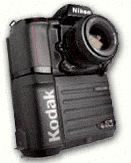Digital Imaging Technology

Departments can share images, access large data bases, and create multiple copies by scanning traditional photographic images and converting them to digital images for distribution to mobile units in the field. The advent of digital cameras changed and challenges the need for traditional photography. A digital photograph can be made, downloaded, saved, and dispersed to the appropriate parties in less time and with less cost than traditional photography. However, is digital photography dependable? Isn’t it too easy to manipulate digital images? What if the computer crashes and the digital information is lost?
When one technological medium supplements or supplants another, there are always questions about the reliability of the newer medium. When photographic materials were new, they were unstable and undependable, using glass plates with light sensitive chemicals was not, then, considered “consistent” or “dependable”. However, the technology, materials, and chemicals evolved into a very consistent, reliable, and archival medium for recording events, gathering visual information, and became a common method of communications.
One issue that seems to haunt digital imaging and particularly digital photography. Is the question of reliable “evidence”. The image can be transformed without an original to validate the print or establish credible representation of the crime scene, right? Well, yes, but traditional photography can be manipulated as well. However, some of these questions are starting in the wrong place because images are exhibits not evidence as the quote from Kodak’s Law Enforcement site puts it:
Imagery Is Not Evidence
“Remember. Imagery is not evidence. Instead, the testimony of a witness is evidence, and the image is an “exhibit” to that testimony. Ultimately, all evidence in a police case revolves around the integrity and veracity of the witness presenting the image, who must demonstrate its authenticity to the court. Furthermore, a person testifying under fear of perjury must explain what the image shows, why it is relevant, how it was acquired, how it came to be in court, and what it implies. The issue therefore is much greater than the image by itself.” (Kodak Professional Law Enforcement)
There are many more questions about digital imaging that are addressed in the Kodak Law Enforcement pages. They have developed a very informative archive of traditional and digital information for Law Enforcement. The section of On the Case is particularly helpful for those developing Digital Imaging Standards and Procedures. The Photo Lab at the SPD uses both traditional and digital imaging. Officer Ruben Borrero is in the process of implementing the standards and procedures for using the digital cameras. The two Kodak DCS 420 digital cameras allow Officer Borrero to download images to a laptop and check the images while still at a crime scene. The images are then written to CD to ensure there are permanent, unaltered originals.
Digital cameras are used throughout the SPD for a variety of purposes. The ID division uses the cameras to reproduce 1-to-1 copies of fingerprints, the CIS Department is creating images for this website, and the Training Division is developing images for internal training on the SPD Intranet. As the SPD develops its use of digital imaging, we will keep you updated.
